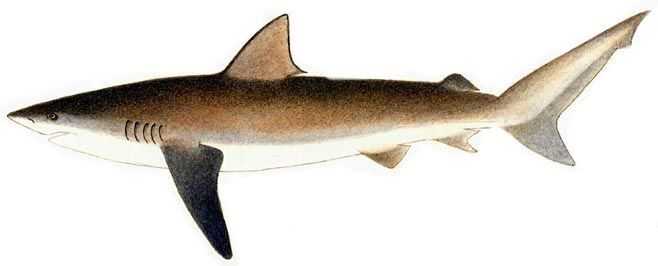Copper Shark

Species Details
Carcharhinus Brachyurus
Carcharhinidae
Carcharhiniformes
Bays, Shoals, Harbors, Continental Shelves, Offshore Islands
374 - 672 lbs.
94" - 132"
Copper Shark (Carcharhinus brachyurus) Fish Description
The Copper Shark also referred to as the bronze whaler or the narrow tooth shark belongs to the species of requiem shark, family Carcharhinidae. It is known to be the only member of its subfamily to be found mostly at temperate latitudes.
It is quite difficult to tell the copper sharks from other large requiem sharks, such as Dusky sharks and can only be differentiated by the distinctiveness of their teeth. The copper shark has short and subtle furrows at the corners of its mouth, which contains 29-35 upper tooth rows and 29-33 lower tooth rows. The copper sharks have a narrow, hook shape to their upper teeth, where their lower teeth are upright. You can also identify the gender of the copper shark by that the adult male copper sharks have longer, narrower, more curved, and finely serrated teeth in comparison to their female counterparts.
The body of the copper shark is a slender, streamlined body with an arched profile from behind its head. They have long, pointed snouts with nostrils lead by low flaps of skin. They have large, round eyes.
The copper shark's pectoral fins are large, pointed, and sickle-shaped. The first dorsal fin of the species is tall, with a pointed tip and concave trailing margin. The second is small and low, positioned opposite of its anal fin. They have a lack of prominent ridge between dorsal fins. The caudal fin has a developed lower lobe, a deep ventral notch nearing the tip of the upper lobe.
Copper sharks, by its name, are bronze to olive-grey above with a metallic-like coat and occasionally a pink cast. The color fades to a dullish grey post mortem. The underside of the copper shark is white, which extends to the flanks as a sort of band.
Copper Shark Diet
The copper sharks mainly feed on cephalopods, bony fishes, and other cartilaginous fishes. The maximum length reported of a copper shark is about 11 feet and weighing up to 672 lbs.
Interesting Facts about Copper Shark
- The oldest known age of the copper shark is 30 years
- The copper shark is the only member of its genus that lives mostly in warm/subtropical rather than tropical waters.
Fishing Techniques
The copper shark is a powerful, large fish with good speed and stamina. Copper sharks have been known to attack people.
But if you’re dead set on angling for one of these bad boys, like the extreme angler you are, you could try at anchoring or drifting with live and dead bait, such as cephalopods, bony fishes, and other cartilaginous fishes, combining it with chum. But even then, when snagging one, it will often attempt to run several times.
Habitat and Distribution
Copper sharks can be found almost throughout the world, in deep, warm temperate, and subtropical waters. Though these coastal, offshore sharks are widespread. It has a varied and uneven distribution. They may frequent shallow areas of either slight, salty brackish waters or freshwater. They have been spotted in large bays, rivers, harbor channels, and in the surf zones. However, they can also be spotted near the sea bottom, recorded to going as deep as 333 ft., but possibly dives down even deeper. So you can see what we mean by a rather patchy distribution.
Where they can be seen regularly are coastal areas, such as in South Africa, Australia, New Zealand. Some even in the Mediterranean, Indo-Pacific, Argentina, southern California, and the Gulf of Mexico. They’re known to migrate with the seasons to the northern part of their range. Northward during spring and summer, and southward during autumn and winter. These changes in latitude are speculated to be related to the shifts in temperature or prey migration.







